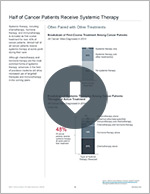Auto logout in seconds.
Continue LogoutRead Advisory Board's take: The 3 takeaways for providers from this proposed rule
FDA on Wednesday released a proposed rule that would require mammogram providers to notify women with dense breasts that the trait could affect the accuracy of their mammograms and might require them to undergo further testing.
The proposed rule marks the first proposed change to FDA's mammography regulations in 20 years.
About mammograms
FDA noted that breast cancer is one of the most common and deadliest cancers among women. In 2018, more than 260,000 women were diagnosed with breast cancer, and more than 40,920 women died from the disease, according to the National Cancer Institute.
Mammograms serve as a critical tool for detecting breast cancer, but they can be difficult to interpret when women have dense breasts with a higher proportion of fibroglandular tissue than fatty tissue—which researchers have identified as a risk factor for developing breast cancer. According to the Washington Post, "Dense breast tissue appears white on a mammogram, as does cancer and some other abnormal changes." As such, FDA said the dense tissue in a woman's breast can conceal signs of breast cancer and lower a mammogram's sensitivity.
Currently, 37 states have laws concerning notifications about breast density.
Proposed rule would require mammogram providers to notify women about breast density
FDA's proposed rule would revise regulations issued under the 1992 Mammography Quality Standards Act, which authorizes FDA to oversee the more than 8,000 mammogram facilities in the United States. The law grants FDA the authority to accredit and annually inspect the facilities and enforce mammogram quality rules.
The proposed rule would establish a national policy requiring mammogram providers to explain to patients how breast density can affect the accuracy of their mammograms. FDA said it included in the proposed rule "specific language" that providers can use when explaining the issue to patients, as well as language to recommend patients with dense breasts talk to their providers about high breast density and how it affects breast cancer risk.
FDA said the proposed rule also would allow the agency to directly notify providers and patients when a facility does not meet quality standards for mammograms and when other breast cancer tests might be required.
According to TEGNA/WTOL, the proposed rule also would add three more categories to mammogram assessments and require providers to give patients more detailed reports of their test results.
Outgoing FDA Commissioner Scott Gottlieb said the proposed rule would modernize how the agency regulates mammography services "by capitalizing on a number of important advances in mammography, like the increased use of 3-D digital screening tools and the need for more uniform breast density reporting."
FDA is accepting public comments on the proposed rule for 90 days.
Comments
Amy Abernethy, FDA's principal deputy commissioner, said, "Given that more than half of women over the age of 40 in the U.S. have dense breasts, helping to ensure patient access to information about the impact that breast density and other factors can have on the risk for developing breast cancer is an important part of a comprehensive breast health strategy." Abernethy said FDA "believe[s] the proposed rule would help empower patients and health care professionals by proposing improvements to the information facilities communicate to them, helping to facilitate the sometimes difficult conversations about potential risks for breast cancer."
Caroline Powers, director of federal relations at the American Cancer Society Cancer Action Network, said the organization is "really pleased to see … FDA has taken the important step to empower women to make informed decisions about their health" (McGinley, Washington Post, 3/27; FDA release, 3/27; LaVito, CNBC, 3/27; Nuyen, TEGNA/WTOL, 3/27; Grady, New York Times, 3/2).
Advisory Board's take

Lea Halim, Senior Consultant and Catherine Kosse, Senior Analyst, Imaging Performance Partnership
This proposed rule is seeking to update the Mammography Quality Standards Act (MQSA), passed in 1992, with the new standards and technology seen in modern mammography screening. It highlights many trends our team closely follows, including increased utilization of 3D mammograms, use of non-traditional breast imaging modalities, and streamlined patient follow-up. Most notably, the proposal upholds the recent national requirement mandating breast density reporting language. If finalized, we'd expect the following three outcomes:
- Growth of 3D mammography volumes: Evidence continues to suggest 3D mammography improves cancer detection in women with dense breasts. Armed with dense breast information, patients may proactively look for programs that offer this screening option. Our 2017 Imaging Benchmarking Survey pinpointed this trend; results showed significant volume growth towards 3D mammography at organizations that offer both screening modalities. As more private payers begin to cover 3D mammography and Medicare continues its coverage policy, organizations should consider the newer modality's advantages, particularly for those women with dense breast tissue.
- Increased coverage, utilization of non-mammography modalities: States such as New Jersey that already require dense breast reporting have witnessed an increase in private payer reimbursement for non-mammogram modalities. One year after New Jersey's breast density law, screening ultrasound increased by 651% and breast MRI use grew by 59.3%. We expect similar trends to happen nationally and recommend programs to offer alternative breast imaging modalities.
- Enhanced role in mammography follow-up, care coordination: The proposed rule reinforces strong mammography patient communication. Patients increasingly expect imaging programs to deliver mammography results and schedule follow-up appointments within the span of 24 to 48 hours. In response to these consumer needs, organizations should develop a program that offers real-time radiology reads, uses technology to streamline results delivery, and operationalizes prompt next steps.
To learn more about efficient breast screening program trends and best practices, register for our 2019 National Meeting series, where you'll also learn how progressive organizations are preserving and growing their margins by doubling down on all imaging efficiency, maximizing revenue capture, and bringing in new market share.
In the meantime, learn more about how to grow market share by improving imaging access and meeting consumer expectations with our report on Streamlining Imaging Access.
Ready-to-present slides: Women’s health market trends for 2019
Want the latest information for your next women's health services meeting? We updated our most popular slides on women's health updated with the latest market trends in 2019. This ready-to-use presentation covers everything from growth outlook and financial considerations to new care management priorities and technology innovations.
Use the slides to frame your next strategy meeting and build a strong foundation for your presentation.
Don't miss out on the latest Advisory Board insights
Create your free account to access 1 resource, including the latest research and webinars.
Want access without creating an account?
You have 1 free members-only resource remaining this month.
1 free members-only resources remaining
1 free members-only resources remaining
You've reached your limit of free insights
Become a member to access all of Advisory Board's resources, events, and experts
Never miss out on the latest innovative health care content tailored to you.
Benefits include:
You've reached your limit of free insights
Become a member to access all of Advisory Board's resources, events, and experts
Never miss out on the latest innovative health care content tailored to you.
Benefits include:
This content is available through your Curated Research partnership with Advisory Board. Click on ‘view this resource’ to read the full piece
Email ask@advisory.com to learn more
Click on ‘Become a Member’ to learn about the benefits of a Full-Access partnership with Advisory Board
Never miss out on the latest innovative health care content tailored to you.
Benefits Include:
This is for members only. Learn more.
Click on ‘Become a Member’ to learn about the benefits of a Full-Access partnership with Advisory Board
Never miss out on the latest innovative health care content tailored to you.


